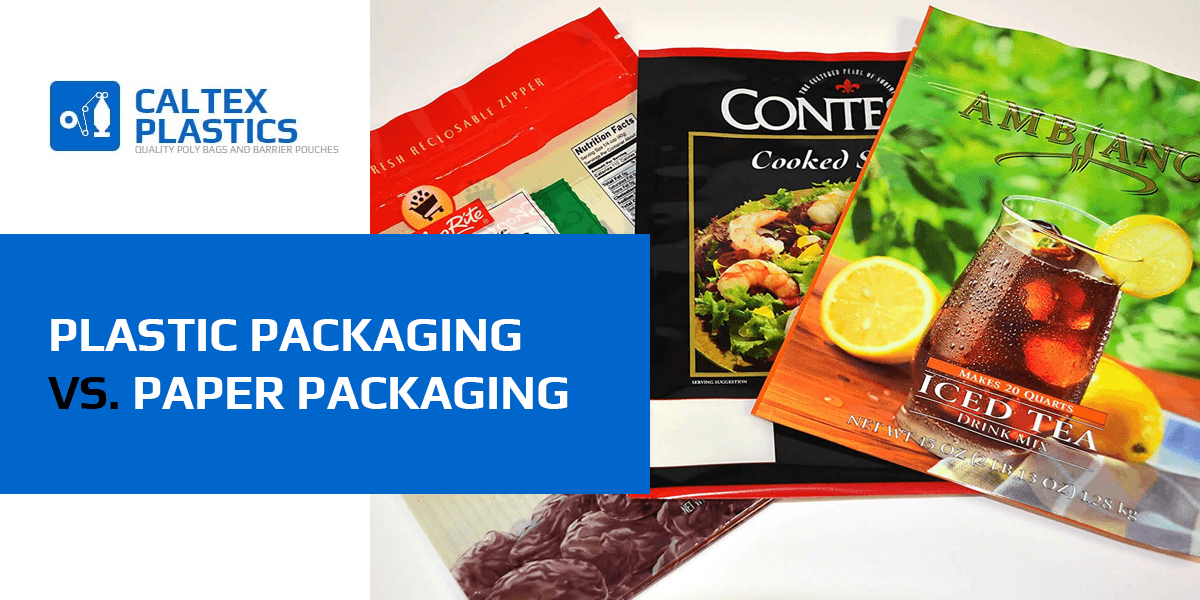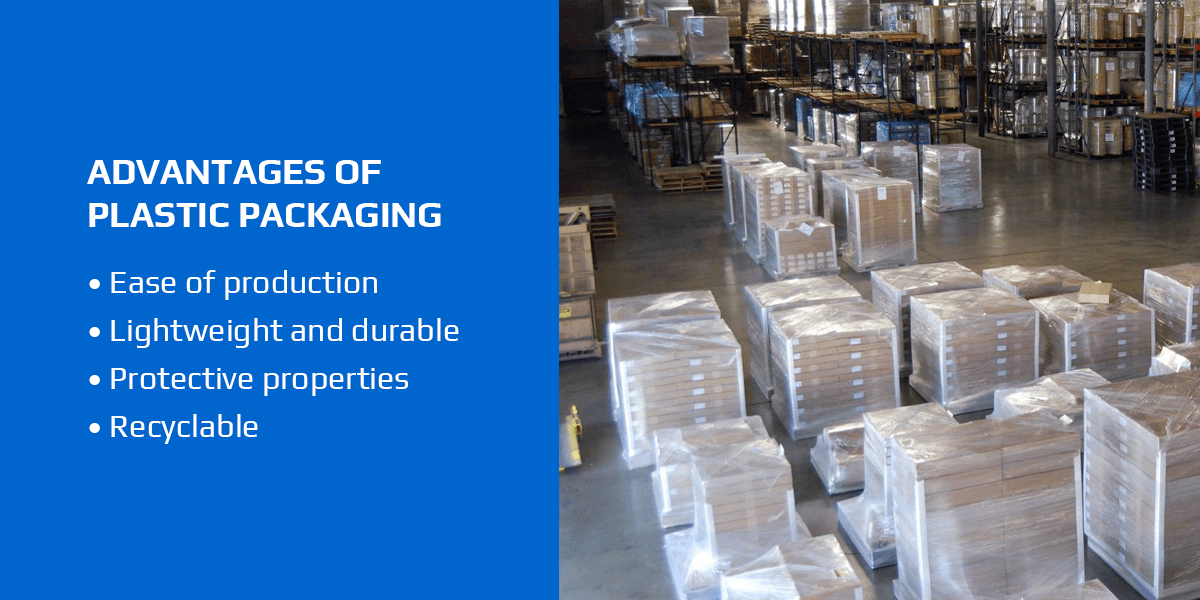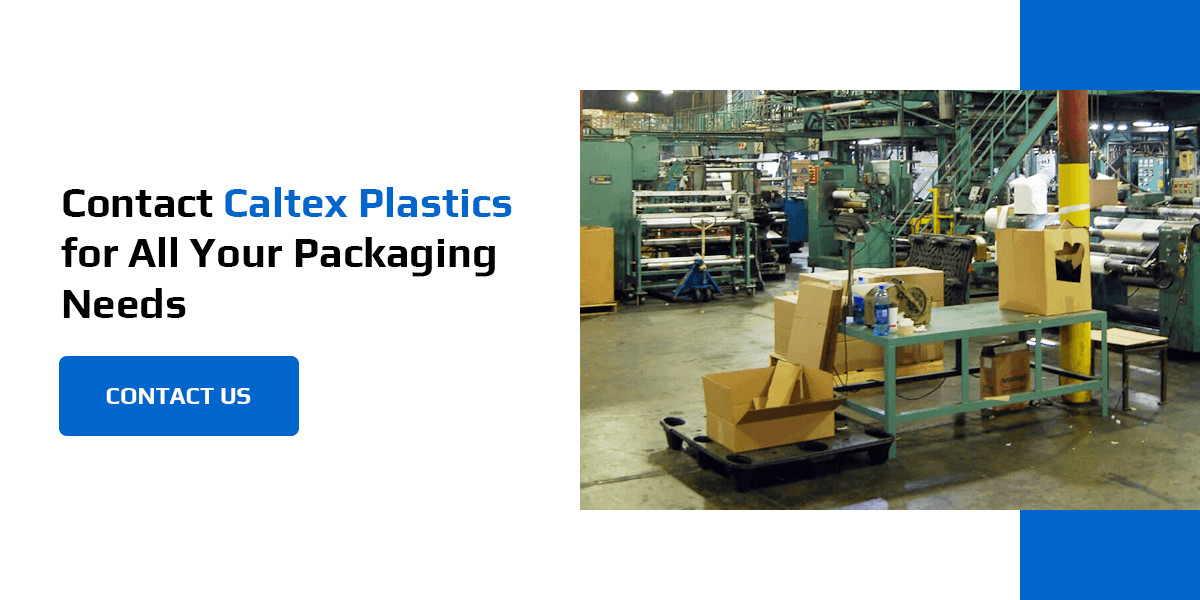PLASTIC PACKAGING VS. PAPER PACKAGING

Posted: July 20th, 2019 Author: Jim Higgs
TABLE OF CONTENTS
Plastic Packaging
Paper Packaging
Which Is More Sustainable, Paper or Plastic Packaging?
Determining Which Is Right for Your Application
Paper or plastic — the age-old question. Each one has its benefits and drawbacks, and the right choice for a business will depend on the application. Plastics offer exceptional convenience and ease of production, while the paper is often touted as an environmentally friendly solution. But this topic is more complex than it may seem. Let’s take a closer look at the paper vs. plastic debate and how these two packaging options compare.
PLASTIC PACKAGING
Though it’s one of the newer packaging materials, plastic is ubiquitous in consumer goods and practically synonymous with single-use packaging. It’s used in everything from food packages to bottles and grocery bags. Plastic packaging includes a wide range of materials and styles and is particularly cost-effective to produce. If you’re working with certain types of products, such as liquids, hygienic medical devices or items that can be damaged by static electricity buildup, plastic packaging is a must-have.

ADVANTAGES OF PLASTIC PACKAGING
Some of the pros of plastic packaging include:
- Ease of production: Plastic packaging is easy, energy-efficient and cost-effective to produce. It can be molded into various shapes for design flexibility and offers many options for colors, transparencies and printing for brand recognition. Plastic also offers options for secure packaging, such as tamper-evident and child-resistant closures.
- Lightweight and durable: Plastic packaging is easier on transportation and handling processes since it weighs less. This leads to reduced fuel use, lower emissions and overall cost savings.
- Protective properties: Whether you need to prevent corrosion or heat and electricity conduction, plastic is a great choice. Special bags are available for especially sensitive products, like electronics, and those that call for hygienic requirements, like food, pharmaceuticals and medical devices. They can be packed and sealed without any human intervention for safe and contaminant-free products. Better barrier technologies also allow plastics to be used for liquids and increase the shelf life of many food products.
- Recyclable: While recyclability will vary between plastics, many can be recycled up to 10 times before quality starts to degrade, making it good for the planet and for consumers who want to do their part.
DISADVANTAGES OF PLASTIC PACKAGING
Of course, there are some cons of plastic packaging:
- Environmental concerns: Plastic packaging poses risks to the environment, primarily in post-consumer handling practices, where it can clog up waterways, fill up landfills or harm wildlife.
- Safety concerns: Depending on the type of plastic and any additives in the material, some plastic packaging can cause adverse health effects, mainly through transmission into food products. Plastic bags can also pose a suffocation risk to animals and children.
- High cost of recycling: While recycling is a significant advantage, it is a complex process, and not all plastics can be recycled. It’s also easy to contaminate plastics with food residue and make them unrecyclable.
- Low melting point: The low melting point of plastic packaging means it can be destroyed if placed near a heat source and it may pose a fire risk in some applications.
PAPER PACKAGING
Paper packaging has been around longer than plastic, and it offers an attractive appearance and few safety or environmental concerns. Paper packaging is popular for many products that are packaged on-site, like restaurant take-out and grocery products. However, it is harder to seal up, making it inappropriate for many food items or other products subject to contamination.
ADVANTAGES OF PAPER PACKAGING
The pros of paper packaging include:
- Total reusability and recyclability: In the right conditions, a paper bag breaks down in about one month, making it easier on the environment after use.
- Safer: Without risky chemicals or suffocation hazards, paper bags are safer for people and animals. Plus, they’re not likely to end up harming ecosystems.
- Attractive: A significant benefit of paper packaging is that it’s good for marketing purposes and creating a positive experience. With a shopping bag, for instance, customers become walking advertisements.
DISADVANTAGES OF PAPER PACKAGING
Some of the cons of paper packaging include:
- Higher production requirements: Paper bags require about five times the energy of plastic bags, use 20 times as much water and weigh more, creating greater greenhouse gas emissions during transportation.
- Not waterproof: Plastic bags won’t support protection for or from liquids.
- More expensive: Paper bags cost an average of 7-10 cents each, with plastic bags only 3 cents apiece.
WHICH IS MORE SUSTAINABLE, PAPER OR PLASTIC PACKAGING?
While many consumers are convinced the most sustainable packaging is paper, the answer is more complex than that and requires looking at the entire life cycle of the packaging.
The process of making paper calls for significant energy and water consumption and creates more solid waste and greenhouse gases, making it more damaging during production. On the other hand, paper is made of renewable resources, while plastic comes from oil, a finite resource. However, only 4% of fossil resources go toward plastics production, and other resource requirements like energy and water, are significantly reduced. Before it gets to the consumer, paper is also heavier and takes up more space, making it more costly to transport.
When it’s time to recycle a plastic or paper bag, the Environmental Protection Agency (EPA) tells us that paper is much more likely to be recycled, with about two-thirds making it in the recycle bin vs. 5% of plastic. Paper is also easier to work with at the recycling plant, since the process is less sensitive to contamination. Still, plastics recycling and production technologies are always evolving for more effective results.
Neither material offers the perfect solution, and many of the perceived benefits of paper bags are offset during the production process, so the question of sustainability is still in flux.
DETERMINING WHICH IS RIGHT FOR YOUR APPLICATION
The difference between plastic bags and paper bags covers many factors, so choosing the right one depends on your application. If you’re working with a product with specific needs for hygiene or resistance to corrosion, contamination and static electricity, plastic is likely the best choice with its dependable barriers. It will also be more versatile and cost-effective, which are advantages for smaller businesses or small-scale shipments.
If cost isn’t as much of a concern and you don’t need any waterproofing, a paper bag can be a good choice. It’s also helpful if you’re looking for a branding opportunity. If you’re still not sure which is best for your product, the experts at Caltex are happy to help.

CONTACT CALTEX PLASTICS FOR ALL YOUR PACKAGING NEEDS
Here at Caltex Plastics, we offer a wide variety of barrier solutions made with polyethylene plastic packaging. We can help protect your products from physical damage, contamination, electromagnetic interference, air, water vapor and static electricity while meeting government specifications and certifications.
We’ve been manufacturing plastic products for decades with responsive customer service, cost-effective products and a vast inventory of material. We operate 24/7 to offer faster turnarounds and service when you need it. To speak with a representative about whether plastic packaging is right for your product, reach out to us today!